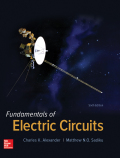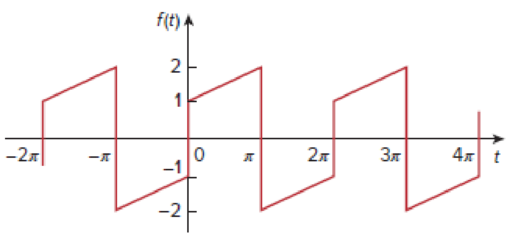
EBK FUNDAMENTALS OF ELECTRIC CIRCUITS
6th Edition
ISBN: 8220102801448
Author: Alexander
Publisher: YUZU
expand_more
expand_more
format_list_bulleted
Concept explainers
Textbook Question
Chapter 17, Problem 60P
Obtain the complex Fourier coefficients of the signal in Fig. 17.62.

Figure 17.62
Expert Solution & Answer
Want to see the full answer?
Check out a sample textbook solution
Students have asked these similar questions
Sketch the output of the analogue computer shown below and find its closest
describing function [suppose any variable to find the DF]
+1
ew2
HI
e2
1.0 +21
LO
SJ
eo
SJ
ew
LO
1.0 +|e1|
HI
-1
ew1 ek(1 + e。)
|e1|
k =
1+|e1|
Figure V-5
Feedback Limiter Behavior
ROUNDED, DUE TO DIODE
NONLINEARITY
LIMIT VOLTAGE
409
DIODE CONDUCTS
First, write the output transaction, then draw the output wave, and then find the
Describing function. I need to solve the question step by step, with an explanation
of each step.
Sketch the output of the analogue computer shown below and find its closest
describing function [suppose any variable to find the DF]
SJ
ew2
ew₁
HI
|e2|
2
LO
1.0 +21
LO
-1
HI
Jel
1.0+|e1|
ROUNDED, DUE TO DODE
NONLINEARITY
LIMIT VOLTAGE
DIODE CONDUCTS
ew1e, -k(1+ e。)
k
=
|e1|
1+|e1|
Figure 1-5 Feedback Limiter Behavior
First, write the output transaction, then draw the output wave, and then find the
Describing function. I need to solve the question step by step, with an explanation
of each step.
Sketch the output of the analogue computer shown below and find its closest
describing function [suppose any variable to find the DF]
SJ
+1
HI
LO
e2
1.0 +21
ew2
eo
SJ
ew₁
LO
Jel
1.0 +|e1|
HI
-1
ew1 ek(1+eo)
k =
|e1|
1+|e1|
First, write the output transaction, then draw the output wave, and then find the
Describing function. I need to solve the question step by step, with an explanation
of each step.
Chapter 17 Solutions
EBK FUNDAMENTALS OF ELECTRIC CIRCUITS
Ch. 17.2 - Find the Fourier series of the square wave in Fig....Ch. 17.2 - Determine the Fourier series of the sawtooth...Ch. 17.3 - Prob. 3PPCh. 17.3 - Find the Fourier series expansion of the function...Ch. 17.3 - Prob. 5PPCh. 17.4 - Prob. 6PPCh. 17.4 - If the input voltage in the circuit of Fig. 17.24...Ch. 17.5 - The voltage and current at the terminals of a...Ch. 17.5 - Find the rms value of the periodic current i(t) =...Ch. 17.6 - Obtain the complex Fourier series of the function...
Ch. 17.6 - Obtain the complex Fourier series expansion of...Ch. 17.7 - Prob. 12PPCh. 17.8 - Rework Example 17.14 if the low-pass filter is...Ch. 17 - Which of the following cannot be a Fourier series?...Ch. 17 - If ft=t,0t,ft+n=ft, the value of 0 is (a) 1 (b) 2...Ch. 17 - Which of the following are even functions? (a) t +...Ch. 17 - Prob. 4RQCh. 17 - Prob. 5RQCh. 17 - If f(t) = 10 + 8 cos t + 4 cos 3t + 2 cos 5t + ,...Ch. 17 - Prob. 7RQCh. 17 - The plot of |cn| versus n0 is called: (a) complex...Ch. 17 - Prob. 9RQCh. 17 - Prob. 10RQCh. 17 - Evaluate each of the following functions and see...Ch. 17 - Using MATLAB, synthesize the periodic waveform for...Ch. 17 - Given that Fourier coefficients a0, an, and bn of...Ch. 17 - Find the Fourier series expansion of the backward...Ch. 17 - Prob. 5PCh. 17 - Find the trigonometric Fourier series for f t =...Ch. 17 - Determine the Fourier series of the periodic...Ch. 17 - Using Fig. 17.51, design a problem to help other...Ch. 17 - Determine the Fourier coefficients an and bn of...Ch. 17 - Find the exponential Fourier series for the...Ch. 17 - Obtain the exponential Fourier series for the...Ch. 17 - Prob. 12PCh. 17 - Prob. 13PCh. 17 - Find the quadrature (cosine and sine) form of the...Ch. 17 - Express the Fourier series...Ch. 17 - The waveform in Fig. 17.55(a) has the following...Ch. 17 - Prob. 17PCh. 17 - Prob. 18PCh. 17 - Obtain the Fourier series for the periodic...Ch. 17 - Prob. 20PCh. 17 - Prob. 21PCh. 17 - Calculate the Fourier coefficients for the...Ch. 17 - Using Fig. 17.61, design a problem to help other...Ch. 17 - Prob. 24PCh. 17 - Determine the Fourier series representation of the...Ch. 17 - Find the Fourier series representation of the...Ch. 17 - For the waveform shown in Fig. 17.65 below, (a)...Ch. 17 - Obtain the trigonometric Fourier series for the...Ch. 17 - Prob. 29PCh. 17 - Prob. 30PCh. 17 - Prob. 31PCh. 17 - Prob. 32PCh. 17 - Prob. 33PCh. 17 - Prob. 34PCh. 17 - Prob. 35PCh. 17 - Prob. 36PCh. 17 - If the periodic current waveform in Fig. 17.73(a)...Ch. 17 - Prob. 38PCh. 17 - Prob. 39PCh. 17 - The full-wave rectified sinusoidal voltage in Fig....Ch. 17 - Prob. 42PCh. 17 - The voltage across the terminals of a circuit is...Ch. 17 - Prob. 44PCh. 17 - A series RLC circuit has R = 10 , L = 2 mH, and C...Ch. 17 - Prob. 46PCh. 17 - Prob. 47PCh. 17 - Prob. 48PCh. 17 - Prob. 49PCh. 17 - Prob. 50PCh. 17 - Prob. 51PCh. 17 - Prob. 52PCh. 17 - Prob. 53PCh. 17 - Find the exponential Fourier series for the...Ch. 17 - Obtain the exponential Fourier series expansion of...Ch. 17 - The Fourier series trigonometric representation of...Ch. 17 - Prob. 57PCh. 17 - Find the exponential Fourier series of a function...Ch. 17 - Prob. 59PCh. 17 - Obtain the complex Fourier coefficients of the...Ch. 17 - The spectra of the Fourier series of a function...Ch. 17 - Prob. 62PCh. 17 - Plot the amplitude spectrum for the signal f2(t)...Ch. 17 - Prob. 64PCh. 17 - Prob. 65PCh. 17 - Prob. 66PCh. 17 - Prob. 67PCh. 17 - Prob. 68PCh. 17 - Prob. 69PCh. 17 - Design a problem to help other students better...Ch. 17 - Prob. 71PCh. 17 - Prob. 72PCh. 17 - Prob. 73PCh. 17 - Prob. 74PCh. 17 - Prob. 75PCh. 17 - Prob. 76PCh. 17 - Prob. 77CPCh. 17 - Prob. 78CPCh. 17 - Consider the full-wave rectified sinusoidal...Ch. 17 - Prob. 82CP
Knowledge Booster
Learn more about
Need a deep-dive on the concept behind this application? Look no further. Learn more about this topic, electrical-engineering and related others by exploring similar questions and additional content below.Similar questions
- Can you help me find the result of an integral 0/2 a² X + a dxarrow_forwardQ1/Sketch the root locus for the system shown in Figure 1 and find the following: a. The exact point and gain where the locus crosses the jo-axis b. The breakaway point on the real axis c. The range of K within which the system is stable d. Angles of departure and arrival R(s) + K(s²-4s +20) C(s) (s+2)(s + 4)arrow_forwardExam2 Subject: (Numerical Analysis) Class: Third Date: 27/4/2025 Time: 60 minutes Q1. For what values of k does this system of equations has no solution? (use Gauss-Jordan eliminations) kx + y + z = 1 x+ky + z = 1 x+y+kz=1arrow_forward
- Consider the Difference equation of a causal Linear time-invariant (LTI) system given by: (y(n) - 1.5y(n - 1) + 0.5y(n = 2) = x(n) a) Implement the difference equation model of this system. b) Find the system transfer function H(z). c) For an input x(n) = 8(n), determine the output response y(n). d) Verify the initial value theorem y(0) with part (c).arrow_forwardQ5B. Find the type of the controller in the following figures and use real values to find the transfer function of three of them[ Hint Pi,Pd and Lead,lag are found so put the controller with its corresponding compensator]. R₁ R₂ Rz HE C2 RA HE R₁ R2 RA とarrow_forwardQ1// Sketch the root locus for the unity feedback system. Where G(s)=)= K S3+252 +25 and find the following a. Sketch the asymptotes b. The exact point and gain where the locus crosses the jo-axis c. The breakaway point on the real axis d. The range of K within which the system is stable e. Angles of departure and arrival.arrow_forward
- Determine X(w) for the given function shown in Figure (1) by applying the differentiation property of the Fourier Transform. Figure (1) -1 x(t)arrow_forwardCan you solve a question with a drawing Determine X(w) for the given function shown in Figure (1) by applying the differentiation property of the Fourier Transform. Figure (1) -1 x(t)arrow_forwardAn inductor has a current flow of 3 A when connected to a 240 V, 60 Hz power line. The inductor has a wire resistance of 15 Find the Q of the inductorarrow_forward
- صورة من s94850121arrow_forwardThe joint density function of two continuous random variables X and Yis: p(x, y) = {Keós (x + y) Find (i) the constant K 0 2 0arrow_forwardShow all the steps please, Solve for the current through R2 if E2 is replaced by a current source of 10mA using superposition theorem. R5=470Ω R2=1000Ω R6=820Ωarrow_forwardarrow_back_iosSEE MORE QUESTIONSarrow_forward_ios
Recommended textbooks for you
 Introductory Circuit Analysis (13th Edition)Electrical EngineeringISBN:9780133923605Author:Robert L. BoylestadPublisher:PEARSON
Introductory Circuit Analysis (13th Edition)Electrical EngineeringISBN:9780133923605Author:Robert L. BoylestadPublisher:PEARSON Delmar's Standard Textbook Of ElectricityElectrical EngineeringISBN:9781337900348Author:Stephen L. HermanPublisher:Cengage Learning
Delmar's Standard Textbook Of ElectricityElectrical EngineeringISBN:9781337900348Author:Stephen L. HermanPublisher:Cengage Learning Programmable Logic ControllersElectrical EngineeringISBN:9780073373843Author:Frank D. PetruzellaPublisher:McGraw-Hill Education
Programmable Logic ControllersElectrical EngineeringISBN:9780073373843Author:Frank D. PetruzellaPublisher:McGraw-Hill Education Fundamentals of Electric CircuitsElectrical EngineeringISBN:9780078028229Author:Charles K Alexander, Matthew SadikuPublisher:McGraw-Hill Education
Fundamentals of Electric CircuitsElectrical EngineeringISBN:9780078028229Author:Charles K Alexander, Matthew SadikuPublisher:McGraw-Hill Education Electric Circuits. (11th Edition)Electrical EngineeringISBN:9780134746968Author:James W. Nilsson, Susan RiedelPublisher:PEARSON
Electric Circuits. (11th Edition)Electrical EngineeringISBN:9780134746968Author:James W. Nilsson, Susan RiedelPublisher:PEARSON Engineering ElectromagneticsElectrical EngineeringISBN:9780078028151Author:Hayt, William H. (william Hart), Jr, BUCK, John A.Publisher:Mcgraw-hill Education,
Engineering ElectromagneticsElectrical EngineeringISBN:9780078028151Author:Hayt, William H. (william Hart), Jr, BUCK, John A.Publisher:Mcgraw-hill Education,

Introductory Circuit Analysis (13th Edition)
Electrical Engineering
ISBN:9780133923605
Author:Robert L. Boylestad
Publisher:PEARSON

Delmar's Standard Textbook Of Electricity
Electrical Engineering
ISBN:9781337900348
Author:Stephen L. Herman
Publisher:Cengage Learning

Programmable Logic Controllers
Electrical Engineering
ISBN:9780073373843
Author:Frank D. Petruzella
Publisher:McGraw-Hill Education

Fundamentals of Electric Circuits
Electrical Engineering
ISBN:9780078028229
Author:Charles K Alexander, Matthew Sadiku
Publisher:McGraw-Hill Education

Electric Circuits. (11th Edition)
Electrical Engineering
ISBN:9780134746968
Author:James W. Nilsson, Susan Riedel
Publisher:PEARSON

Engineering Electromagnetics
Electrical Engineering
ISBN:9780078028151
Author:Hayt, William H. (william Hart), Jr, BUCK, John A.
Publisher:Mcgraw-hill Education,
Intro to FOURIER SERIES: The Big Idea; Author: Dr. Trefor Bazett;https://www.youtube.com/watch?v=wmCIrpLBFds;License: Standard Youtube License